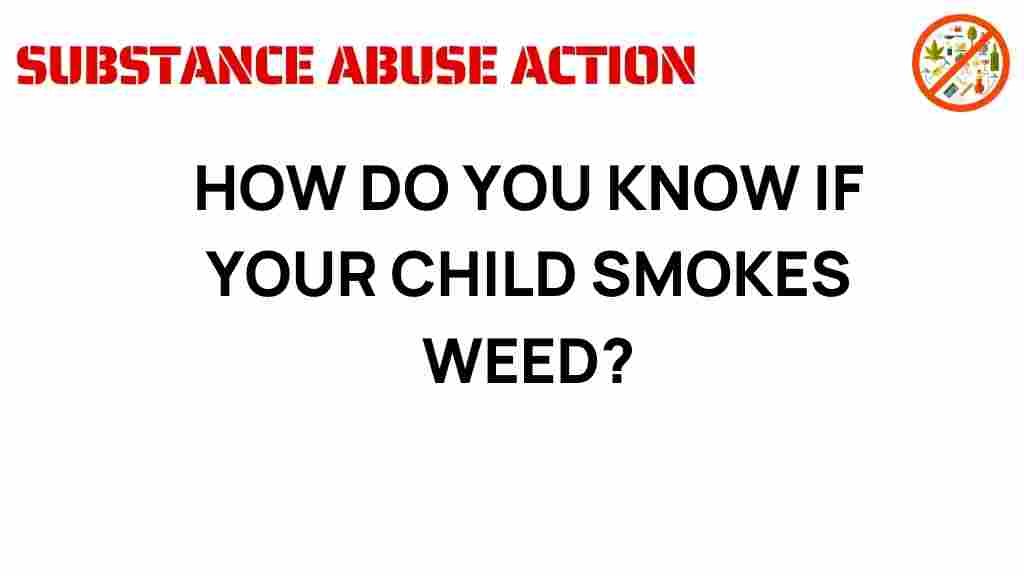Uncovering Signs: Is Your Child Experimenting with Marijuana?
As a parent, navigating the adolescent years can be a daunting task, especially when it comes to understanding the behaviors of your child. One particular concern that often arises is substance abuse, specifically marijuana use. With the increasing legalization and normalization of cannabis in many parts of the world, it’s crucial for parents to be vigilant and informed about the signs of use. In this article, we will explore the signs of marijuana use among youth, effective parenting strategies, and ways to foster open family communication regarding drug awareness.
Understanding Marijuana and Its Impact on Youth Behavior
Marijuana, also known as cannabis, is one of the most commonly used substances among adolescents. Its psychoactive properties can significantly affect adolescent health, impacting brain development, academic performance, and social interactions. Understanding the risks associated with marijuana use is essential for parents aiming to protect their children from potential harm.
Recognizing the Signs of Use
Identifying the signs of marijuana use can be challenging, as many behaviors may be attributed to typical adolescent development. However, being aware of specific indicators can help parents take proactive measures. Here are some common signs of use:
- Changes in Behavior: Noticeable shifts in mood or behavior, including irritability, increased secrecy, or withdrawal from family activities.
- Physical Signs: Bloodshot eyes, frequent nosebleeds, or unusual smells on clothing or breath can be indicators of marijuana use.
- Academic Decline: A sudden drop in grades or loss of interest in school can be a red flag for substance abuse.
- Social Changes: New friends or changes in social circles that align with marijuana use can signal experimentation.
- Increased Appetite: Often referred to as “the munchies,” an unusual increase in appetite may be associated with cannabis use.
Step-by-Step Process: How to Approach the Topic with Your Child
When you suspect your child may be experimenting with marijuana, approaching the topic requires sensitivity and care. Here’s a step-by-step guide to facilitate a constructive conversation:
- Educate Yourself: Before initiating a conversation, gather information about marijuana, its effects, and the current youth behaviors associated with substance abuse.
- Choose the Right Time: Find a calm and private setting for the discussion, ensuring your child feels safe and comfortable.
- Express Concern, Not Accusation: Start the conversation by expressing your concern for their well-being rather than making accusations. Use “I” statements to communicate your feelings.
- Listen Actively: Give your child an opportunity to express their thoughts and feelings. Listen without interrupting, showing that you value their perspective.
- Discuss the Risks: Educate your child about the potential risks associated with marijuana use, including its impact on health and development.
- Encourage Open Communication: Let your child know that they can talk to you about anything without fear of judgment or punishment.
Troubleshooting Tips: What If Your Child Denies Use?
If your child denies using marijuana despite your concerns, consider these troubleshooting tips:
- Look for Other Signs: Continue to observe their behavior for any additional signs of substance use or changes in patterns.
- Stay Engaged: Keep the lines of communication open. Regularly check in with your child about their friends, school, and other activities.
- Encourage Healthy Alternatives: Promote involvement in sports, clubs, or hobbies that can provide positive outlets for stress and social interaction.
- Consult a Professional: If your concerns persist, consider seeking advice from a counselor or therapist who specializes in adolescent health and substance abuse.
Fostering Drug Awareness in the Family
Creating a culture of drug awareness within your family can help prevent substance abuse. Here are some strategies to foster this environment:
- Open Discussions: Regularly talk about drugs and alcohol as part of your family conversations, making it a normal topic without stigma.
- Share Resources: Provide your child with educational resources about marijuana, including the legal implications and health risks. Websites like National Institute on Drug Abuse can be useful.
- Model Healthy Behavior: Demonstrate healthy lifestyle choices. Your behavior significantly influences your child’s choices and attitudes toward drugs.
- Encourage Critical Thinking: Discuss media portrayals of marijuana and challenge your child to think critically about the messages they receive.
Conclusion: The Importance of Family Communication
As a parent, recognizing the signs of marijuana use in your child is crucial for their health and well-being. By fostering open communication, educating yourself about substance abuse, and implementing proactive strategies, you can create a supportive environment that encourages healthy choices. Remember, being informed and engaged is key to navigating the complexities of adolescent behavior and ensuring your child’s safety.
For more information on family communication and adolescent health, consider checking out our resources on effective parenting strategies.
Ultimately, being vigilant and proactive in addressing the signs of marijuana use can make a significant difference in your child’s life, guiding them towards a healthier future free from substance abuse.
This article is in the category Prevention and created by SubstanceAbuseAction Team
